Abstract
The straddle-type monorail tour transit system is a light overhead steel structure, and the lateral stiffness is generally low. However, the limit of the lateral natural vibration frequency is not clear in the current codes of China, and designers may ignore it. Weak lateral stiffness will lead to a violent vibration during vehicle operation and crowds walking, affecting human comfort and structural safety. Based on a practical project, we tested the acceleration of a monorail vehicle under full load conditions, and its running stability and ride comfort were assessed. Then, the impact of pedestrians on lateral vibration under some working conditions was measured and analyzed. Furthermore, the influence of different structural parameters on the lateral fundamental frequency was investigated. The results showed the following: (i) The vehicle’s running stability and riding comfort was good. However, human comfort was poor due to the weak lateral stiffness of the structure, which was affected by human-induced vibration. (ii) The comprehensive response of the structure increased with the increase in walking frequency, increased with the increase in the number of people working or weight, and the growth speed slowed down. (iii) The structural stiffness was most sensitive to the change in steel column diameter. (iv) The recommended value of the lateral fundamental frequency limit for different spans of the straddle-type monorail tour transit system was put forward. The recommended lower limit of fundamental frequency for a 15 m span is 5.0 Hz, for an 18 m span it is 3.5 Hz, and for a 25 m span it is 2.8 Hz.
1. Introduction
In recent years, with the rapid development of tourism and the improvement in the awareness of natural landscape protection, more and more people have begun to think about how to develop the tourism industry while protecting the original style of the scenic spot and adapting to the complex and changeable terrain conditions. Therefore, the straddle-type monorail tour transit system (MTTS) has gradually been popularized. As a new type of rail transit, it has the advantages of a small land area, short construction period, strong climbing ability, and strong terrain adaptability [1,2,3,4]. More than 30 projects have been completed or are under construction in China, and typical projects are shown in Figure 1.
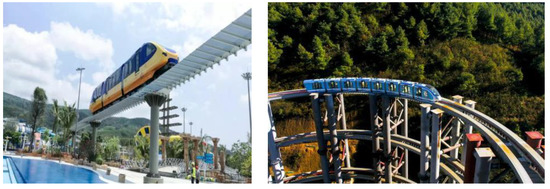
Figure 1.
Single track monorail project (left) and double track monorail project (right).
Unlike the traditional monorail systems and railways, most MTTS have adapted elevated steel structures with lightweight beams and heavy-weight vehicles, showing the characteristics of small dead loads and large live loads. Therefore, the dynamic response of the track structure during vehicle operation may be notable [5,6,7,8]. The tracking subsystem of MTTS is composed of a track structure and a maintenance and evacuation platform for relevant personnel. The track structure bears the vehicle load and acts as a rail. Different from the traditional wheel–rail contact, the wheel–rail contact of the MTTS is a rubber wheel contact, which also makes the research results of the traditional railway unable to be applied to the research of MTTS [9,10,11]. With the development of MTTS towards long-span use, the dynamic interaction problem of track structure is becoming highly prominent. While taking the vehicle or walking on the evacuation platform, a notable vibration response may be present, which may cause human discomfort or even reduce the safety and service life of the structure [12,13,14]. Thus, reducing the system’s dynamic response [15,16,17,18,19,20,21,22,23] and improving the comfort of humans [24,25,26,27] have been researched topics of great concern.
For the MTTS, the crowd belongs to an eccentric excitation force on the structure, and the periodic lateral load will generate with walking, resulting in the lateral vibration of the system. This problem has not received enough attention from engineers. In recent years, some large-span structures have also experienced evident lateral vibrations caused by pedestrians. The Millennium Bridge in London, UK, has experienced a severe lateral vibration due to pedestrians, which has seriously affected pedestrian comfort and safety, resulting in a significant phenomenon of “collective synchronization” of walking [28]. He [29] et al. considered people as a time-varying dynamic model. They established the coupling dynamic equation between the beam and the human to study the dynamic response of the people and the structure. The results showed that a person’s natural frequency, walking frequency, and speed were important factors affecting the structure’s dynamic response and the person’s comfort. Many studies have also analyzed structural vibration and its impact on comfort and studied methods to reduce vibration and improve comfort [30,31,32]. The technical code for urban pedestrian overpasses and pedestrian underpasses [33] is the main code for designing pedestrian bridges in China. The frequency-adjustment method is adopted to consider the vertical vibration of the structure, and the vertical frequency is required to be no less than 3 Hz. However, the code does not provide further suggestions or methods for evaluating vibration serviceability that cannot meet the code’s requirements, and the problem of lateral vibration is still unresolved. Although there are differences between MTTS and pedestrian bridges, the research results of pedestrian bridge vibration have significance for the research on pedestrian structure vibration of the evacuation platform of the MTTS.
Based on a practical project, firstly, the vehicle full load operation dynamic test was carried out by counterweight simulating passenger load, the single vibration “Sperling” index was analyzed to evaluate the vehicle’s running stability, and the ride comfort was studied. Furthermore, in the human-induced vibration test, the different numbers of people and frequencies had different effects on the lateral vibration response of the structure. In this paper, a deterministic pedestrian load model was introduced to explore the influence of the number of people and step frequency on the structural response through the control variable method. The sensitivity of the parameters, such as the thickness of the track wall plate, the wall thickness of the column, the height, and the diameter, was analyzed using the finite element method. Finally, based on pedestrian comfort, the comfort standard specified in the German EN03 (2007) specification was taken as the basis, and in combination with some provisions of the domestic GB50458-2008 Code for Design of Straddle Monorail Transit, the recommended limit values for the lateral fundamental frequency of different spans of the steel structure monorail system were proposed.
2. Test Overview
2.1. Project Introduction
The project included a circular line with a total length of 341.6 m. The experimental research was carried out only for three spans. The spans were 14.125 m, 17.875 m, and 20.768 m. The column diameters were 400 mm, 600 mm, and 700 mm. The section mainly included straddle-type monorail vehicles, tracks, columns, and evacuation platforms. The section form of the MTTS is shown in Figure 2.
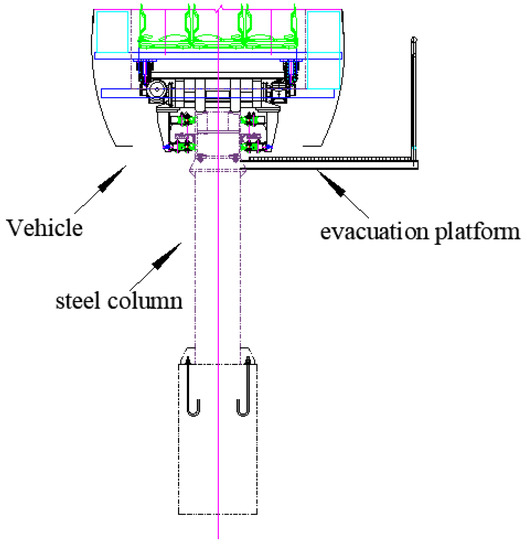
Figure 2.
Section form of MTTS.
2.2. Test Content
The project was located in a construction area. According to the site conditions, we selected the period without construction, and the wind speed was less than 1.0 m/s (no wind or weak wind) to avoid the impact of the construction environment and wind-induced vibration on the test. The test was divided into three parts: (i) Dynamic characteristic test. The residual vibration method was adopted. The vehicle ran freely through the track, and then the free attenuation signal in the structural response was extracted for modal parameter identification. (ii) Vehicle running performance test. When the vehicle ran typically, we measured the three-dimensional acceleration of the vehicle floor, then analyzed its running stability and ride comfort. (iii) Human-induced vibration test. When pedestrians walked on the evacuation platform, the acceleration response at the maximum point of the track and the pier top amplitude were tested.
2.3. Layout of Measuring Points
The test instrument included eight acceleration sensors with a sensitivity of 0.33 m/s2, two displacement meters with a sensitivity of 0.1183 mv/mm, and a YSV8008 dynamic signal-acquisition instrument with eight channels. The vibration response of the track under random load excitation was measured, and the natural vibration characteristics of the structure were obtained by spectrum analysis.
In the test, ten lateral and vertical acceleration measuring points were located at the mid-span and side column of the test section, numbered H/S 1–5 from left to right. Two amplitude measuring points were located at the top of two columns in the middle of the test section. The vehicle ran on the whole line under full load, and five measuring points were located on both sides’ bottom mounting surface and the floor surface of the cushion. The layout of the measuring points is shown in Figure 3.
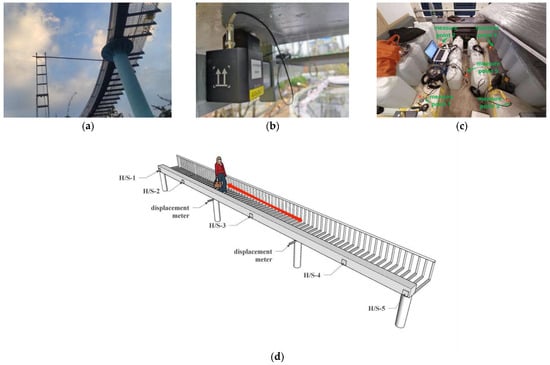
Figure 3.
The layout of measuring points. (a) Amplitude measuring point; (b) vibration sensors; (c) vehicle measuring points; (d) overview of walking route and measuring points.
3. Dynamic Characteristics and Comfort Analysis
3.1. Dynamic Characteristics Analysis
The residual vibration method was used to study the structure’s dynamic characteristics. After analysis, the results of the span acceleration spectrum analysis were similar. This paper extracted the signal of a mid-span acceleration sensor, analyzed the time-frequency domain characteristics of the attenuation signal, and obtained the structure’s first four natural vibration frequencies, as shown in Table 1. At the same time, the finite element model was established by ANSYS for analysis. The theoretical analysis agreed with the experimental results, and the finite element model could be further applied to relevant research. We took lateral acceleration as an example. The test signal analysis and third-order vibration mode are shown in Figure 4 and Figure 5.

Table 1.
The first four frequencies of the structure.

Figure 4.
Time history and frequency domain signal of acceleration by the residual vibration method.

Figure 5.
Mode and frequency.
The MTTS is a single-column structure. Combined with Figure 5 and Table 1, the first three-track mode was lateral bending, and the lateral fundamental frequency was 1.82 Hz. This indicates that its lateral stiffness was weak, and the lateral fundamental frequency was close to the walking frequency of tourists, which easily causes resonance. Therefore, in the design of MTTS, designers should focus on controlling the structure’s lateral stiffness.
3.2. Vehicle Operation Performance Analysis
The MTTS belongs to amusement facilities with high running stability and ride comfort requirements. Ride comfort reflects passengers’ subjective feelings about vibration frequency and magnitude. In addition to having the same effect as ride comfort, running stability reflects the train vibration’s objective frequency and extent [34]. Various vibrations affect the train’s running stability and ride comfort during vehicle operation.
The Sperling stability index wi of a single vibration was analyzed and calculated according to the literature [35]. The vehicles running in the circle line at an average driving speed were evaluated according to the time history. After the 0.5–40 Hz band-pass filter filtered the vibration acceleration of each measuring point, the stability index was calculated every 5 m [36]. The method in UIC 513-1994 specification [37] of the International Union of Railways was used to study ride comfort. We took some measuring points as examples. The distribution of the stability and comfort index with time is shown in Figure 6 and Figure 7.
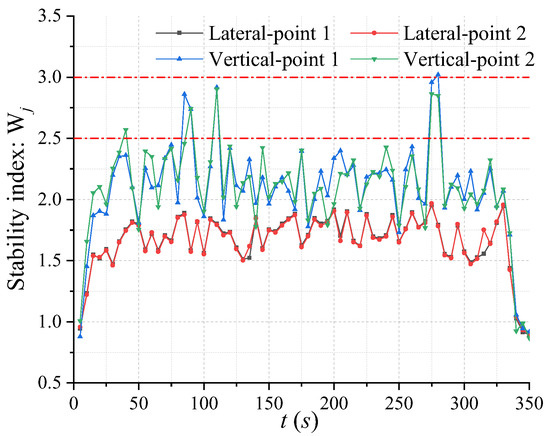
Figure 6.
Stability index under full load operation.
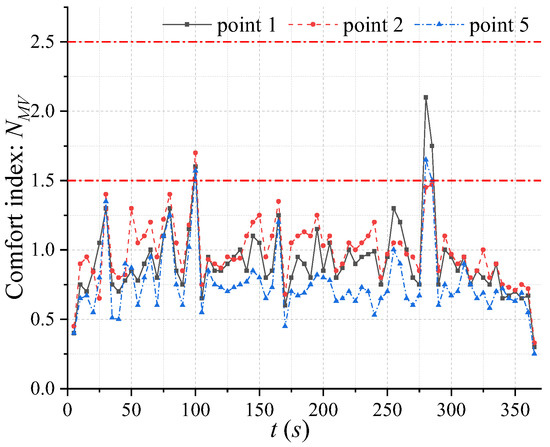
Figure 7.
Comfort index under full load operation.
The results showed that the lateral stability index of each measuring point was smaller than the vertical stability index at full load, indicating that the vehicle’s lateral stability was better than the vertical stability. Only 1.4% of the vertical indicators exceeded the qualified line in the whole process. The comfort index met the “comfort” standard. Generally speaking, the vehicle operation performance under full load was good.
3.3. Human-Induced Vibration Analysis
The monorail system vehicle acts vertically on the track subsystem. With the track structure’s refined fabrication and the curved sections’ speed limit requirements, the track will not normally generate excessive vibration during vehicle driving. Relevant research [6,38] has shown that the monorail system vehicles’ running stability and riding comfort are good. When pedestrians walk on the evacuation platform, the crowd load acts eccentrically on the main structure of the MTTS. The lateral stiffness of the MTTS is relatively weak, and the designers cannot ignore the lateral vibration caused by the crowd load. Therefore, this paper only studied the lateral response of human-induced vibration.
Three people (A, B, and C) participated in the human-induced vibration test. The test conditions were divided into multi-person and multi-frequency walking to study the impact of the number of excitations and frequency on the structural response. A stopwatch timer controlled the excitation frequency. The acquisition time of each condition was 10 s. At the same time, 10-person excitation conditions were simulated. Table 2 shows the specific condition information, and the walking route is shown in Figure 3d. The field test is shown in Figure 8.

Table 2.
Conditions information.
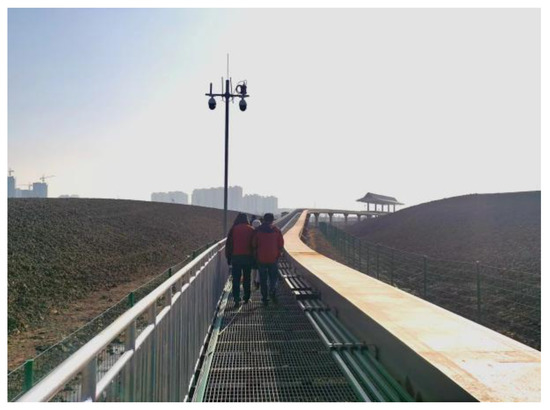
Figure 8.
Field test.
When people generally walk on the evacuation platform, there is a slight lateral amplitude on the top of the column. The measured lateral amplitude on the top of a column is shown in Figure 9. It can be seen from the analysis that when the vibration was excited at the frequency of 2 Hz, the lateral amplitude of the column top was the measured maximum value in all cases, which is consistent with the results of the measured and finite element analysis that the fundamental frequency was about 2 Hz. The maximum amplitude of the pier top met the requirement that the lateral displacement shall not exceed 15 mm as specified in the reference [39].
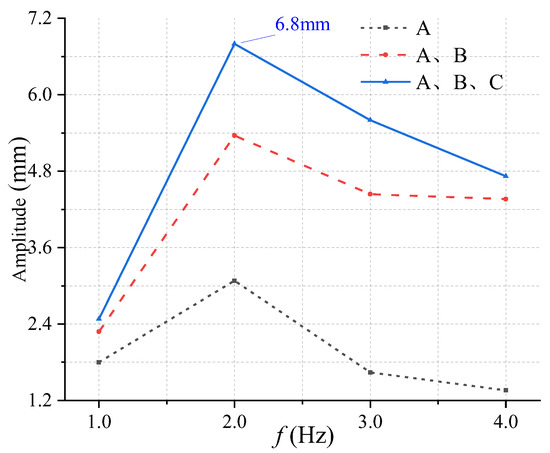
Figure 9.
Lateral amplitude.
Compared with the fundamental vertical frequency, the fundamental lateral frequency was smaller and closer to the human gait frequency, which more easily produces lateral vibration. The fundamental vertical frequency met the comfort requirements specified in the Chinese CJJ69-95 code [33], so this paper only studied the lateral response of human-induced oscillation.
There are two methods to evaluate the comfort of human-induced vibration, avoiding the sensitive frequency method and limiting the dynamic response value method. Avoiding the sensitive frequency method requires that the natural vibration frequency of the structure deviates from the step frequency range to prevent man–bridge resonance. The limited dynamic response method requires that the maximum vibration acceleration of the system meet the comfort limit requirements [40,41,42]. The existing pedestrian bridge specifications at home and abroad have different provisions for human-induced vibration (Table 3). Among them, the Chinese specifications do not specify the lateral comfort standard. The German code considers the influence of the deviation between the structural frequency and the pedestrian step frequency on the structure and believes that the system will have a severe vibration response only when the fundamental structural frequency is close to the pedestrian step frequency [43,44]. We combined the resonance characteristics of modern steel structure bridges and the actual pedestrian crossing experience. This paper used the method of pedestrian acceleration limit specified in the design guide EN03 (2007) to evaluate comfort. The comfort distribution of human-induced vibration is shown in Figure 10.

Table 3.
Current codes on human-induced vibration at home and abroad.
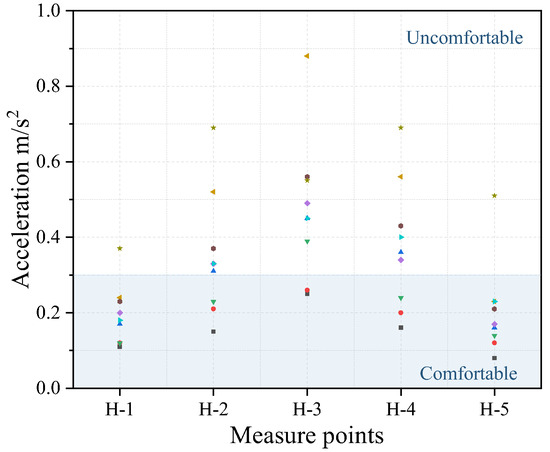
Figure 10.
Comfort distribution of human-induced vibration.
Table 3 and Figure 10 show that the self-reported walking experience was relatively poor. For MTTS, even if the driving comfort is good, there is still a problem of poor pedestrian comfort. The lateral fundamental frequency of the structure should be controlled by considering the factors of pedestrian comfort. However, the current domestic specifications do not consider the impact of pedestrians on the lateral dynamic response of the structure, and there are hidden dangers in comfort and safety. Therefore, it is important to clarify the corresponding design parameters.
4. Analysis of Different Parameters
4.1. Pedestrian Load Model
During the complete gait cycle of pedestrian walking, the center of gravity fluctuates up and down, and the force acting on the evacuation platform changes constantly. The single-person continuous load model mainly includes the deterministic and random load models. The deterministic load model is commonly used in engineering to describe the walking load [45], as shown in Equation (1):
where G is the pedestrian weight, n is the order of the function, t is the time, fp is the walking frequency, βi is the coefficient of the ith order Fourier series, and Φi is the phase angle of the ith order load. β1 = 0.2611fp − 0.2109, β2 = 0.09, β3 = 0.077, Φ1 = Φ2 = Φ3 = 0.
According to relevant research results [29,46,47,48], this paper selected the single-person load step frequency of slow walking as 1.0 Hz, normal walking as 2.0 Hz, fast walking or running as 3.0 Hz, and the load walking curve is shown in Figure 11.
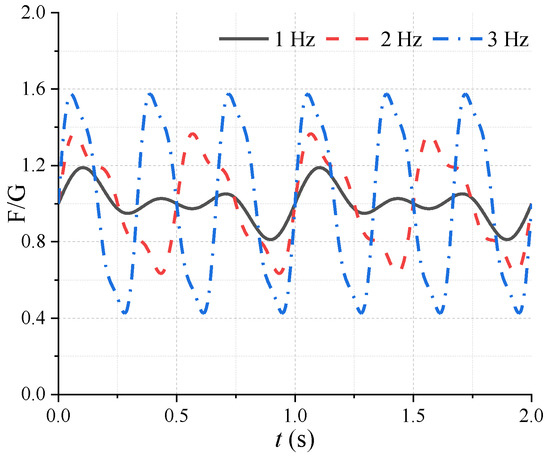
Figure 11.
Time history curve of single person walking load.
4.2. Influence of the Number of People on the Structural Response
The root-mean-square (RMS) of acceleration is a function of time. Considering the influence of the overall acceleration response in the time history, it can better reflect the attribute of structural response than the peak acceleration [49,50]. This paper divided the acceleration time history data into calculation windows by 0.5 s, and the RMS of acceleration in each window was calculated by MATLAB (Equation (2)). For condition one, the acceleration time history and the RMS curve of measuring point H-3 are shown in Figure 12.
where aw(t) is the acceleration time history (m/s2), T is the total time (s), and aw is the RMS of acceleration within the calculation window.
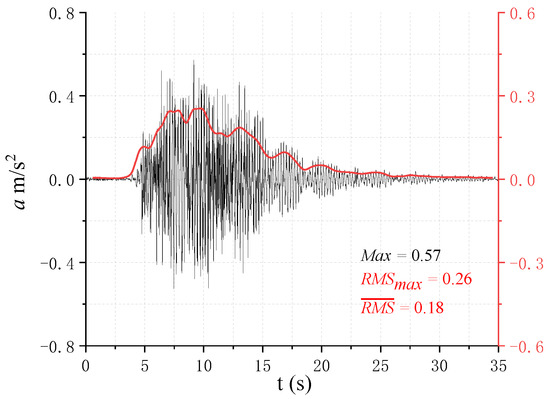
Figure 12.
Acceleration time history and RMS.
To study the influence of the number of pedestrians on the structural response of MTTS, we arranged different numbers of pedestrians to walk back and forth for 10 s along the walking route shown in Figure 3d. The relationship between the number of pedestrians or weight and the acceleration response is shown in Figure 13, where arms represents the maximum RMS of acceleration. The results show that when the number of pedestrians increased from 1 to 2, the RMS of acceleration response rose significantly. When the number of pedestrians increased from 2 to 3, the increase in response was relatively small. The structural response increased with the number of people and body weight, and the growth rate slowed. In addition, the reaction of measuring points H-1 and H-5 under various working conditions was slight because the measuring points were far from the excitation position, and it had the same section as the column. The lateral restraint of the column on the structure made its vibration weak. The acceleration of measuring point H-3 was the maximum value under the same condition because the measuring point was located at the mid-span of the personnel walking section, where the excitation was the largest. Still, the constraint was relatively weak, making its vibration the most obvious.
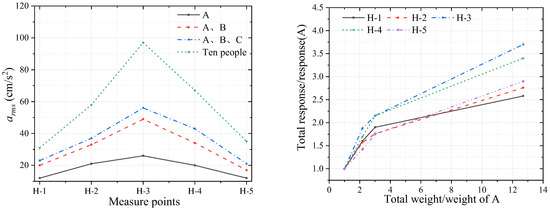
Figure 13.
RMSmax at different numbers.
4.3. Influence of Walking Frequency on Structural Response
To study the influence of walking frequency on the structural response of MTTS, we arranged different numbers of pedestrians to step back and forth at 1, 2, and 3 Hz along the walking route shown in Figure 3d for 10 s. The relationship between walking frequency and the acceleration response of each measuring point is shown in Figure 14. The results show that the overall reaction of the track increased with the increase in walking frequency. For the same number of people, when the walking frequency increased from 1 Hz to 2 Hz, the structural acceleration response rose significantly. When the walking frequency increased from 2 Hz to 3 Hz, the ratio of excitation frequency to structural natural frequency (1.82 Hz) increased from 1.10 to 1.65, but the acceleration response of each measuring point decreased. When the walking frequency was 2 Hz, there was a possibility of man–bridge resonance. The measuring points H-1 and H-5 were in the same section with the column, and the lateral restraint of the column on the structure made its vibration weak.
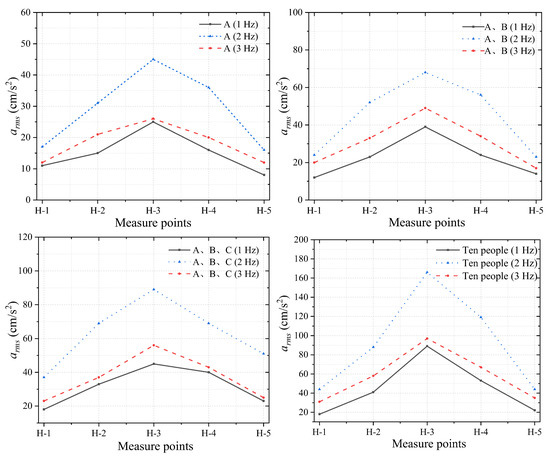
Figure 14.
RMSmax at different frequency.
4.4. Methods of Increasing Structural Stiffness
It is necessary to analyze the fundamental frequency changes to evaluate the sensitivity of structural stiffness changes to different structural parameters. The structural parameters were consistent with the engineering examples analyzed in Section 2.1. The change of fundamental structural frequency under various conditions was analyzed by adjusting the track wall thickness and the column wall thickness, height, and diameter. The changing trend of fundamental structural frequency under different structural parameters is shown in Figure 15.
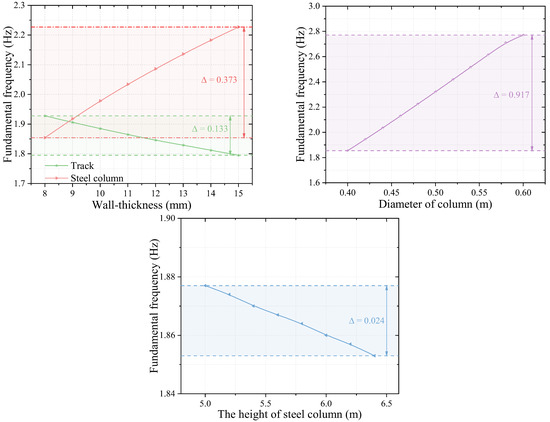
Figure 15.
Change trend of fundamental frequency of structure.
Through analysis, the fundamental frequency of the structure changed obviously with the structural parameters. If we adjusted the structural parameters slightly within a reasonable range, there were differences in the change range of the fundamental frequency of the structure. The fundamental frequency changed the fastest with the diameter of the column, the wall thickness of the column changed the second-fastest, and the change of speed with the height of the column was the slowest. That is, the structural stiffness was the most sensitive to the change in the diameter of the column, and the sensitivity to the height of the column was relatively weak. In design, when the structural rigidity does not meet the requirements, we suggest first considering adjusting the diameter of the column.
5. Study on the Limit of the Fundamental Lateral Frequency
5.1. Analysis of Human-Induced Vibration
The ANSYS established the finite element model. According to the deterministic load model defined in Section 4.1, the time history analysis was carried out by walking in unison within the whole span. The acceleration response corresponding to the measuring point H-3 is shown in Figure 16. The simulation was in good agreement with the measured result.
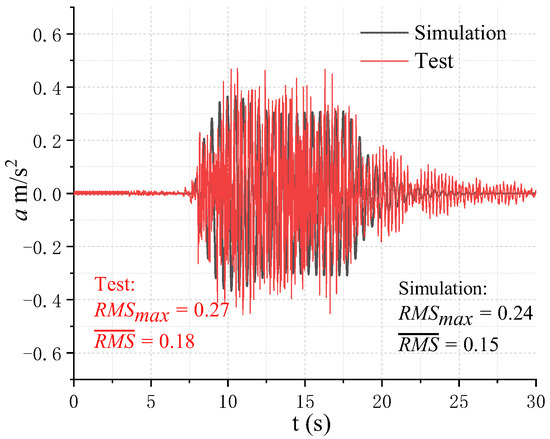
Figure 16.
Comparison between simulation and measured.
Since the evacuation platform is the main structure for evacuating tourists, more than one person will likely be walking on it simultaneously. This paper used 15 people walking simultaneously, with an interval of 1 m between the front and back of the group, walking at a step frequency of 2 Hz. The lateral vibration peak acceleration did not exceed 0.3 m/s2 according to the standards in the German EN03 (2007) code that analyzed the lateral fundamental frequency limit of domestic MTTS. We considered that the weight of a single person was 70 kg. The load walking curve is shown in Figure 17.
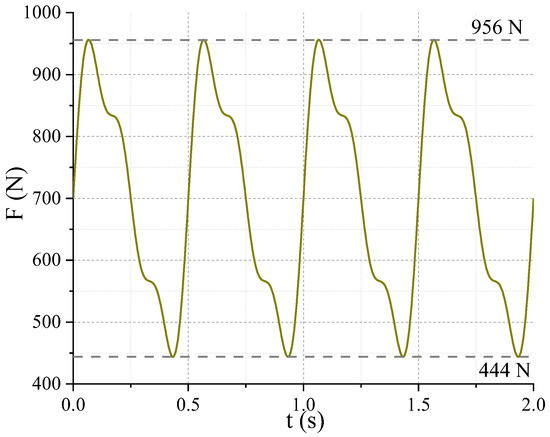
Figure 17.
Time history of walking load.
5.2. Discussion on the Limit of the Fundamental Frequency
It is necessary to analyze their acceleration response to evaluate whether structures with different stiffnesses produce excessive vibration under pedestrian load. To study the influence of structural stiffness on the structural response of the MTTS, we used the walking load in Figure 17 as the excitation condition. The German EN03 (2007) code stipulates that the lateral acceleration of the structure is not more than 0.3 m/s2 from the perspective of pedestrian comfort, and the lateral fundamental frequency limit of the straddle PC structure without pedestrians in the Code for Design of Straddle Monorail Traffic GB50458-2008 is 70/L (L represents the bridge span). This paper also considered avoiding the sensitive frequency and limiting the dynamic response. Through finite element analysis, it explored the value of the lateral fundamental frequency of the structure when the lateral acceleration was just below 0.3 m/s2 to ensure that the pedestrian comfort reached the “comfort” standard. In combination with the horizontal fundamental frequency value specified in GB50458-2008 Code for Design of Straddle type Monorail Transit, the larger value of the two was taken as the lower limit of the fundamental lateral frequency of the span straddle type monorail tourism transportation system from the perspective of safety. For the span length of 18 m, the time history curve of the lateral acceleration response of the structure in the span with different lateral stiffnesses is shown in Figure 18. The lower limit of the fundamental lateral frequency of different spans is shown in Table 4.
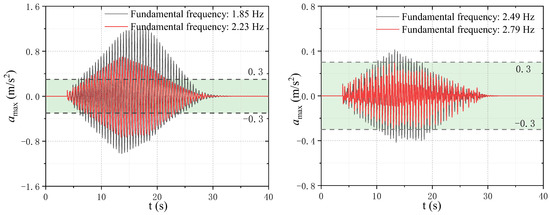
Figure 18.
Time history of lateral acceleration in mid-span.

Table 4.
Lower limit of horizontal fundamental frequency of different spans.
It can be seen from Table 4 that, at the same span, with the increase in the lateral stiffness of the structure, that is, the increase in the lateral fundamental frequency, the lateral acceleration response in the middle of the span decreased. For MTTS, this paper suggests that the lower limit of the fundamental frequency for the span length of 15 m is 5.0 Hz, for 18 m it is 3.5 Hz, and for 25 m it is 2.8 Hz.
6. Conclusions
This paper used a straddle-type monorail tour transit system as the background for an experiment. We systematically studied vehicle running stability and pedestrian and riding comfort based on the tracks’ dynamic characteristics. In addition, we used the finite element analysis method to control the lateral vibration of the MTTS and put forward the recommended value of the lateral fundamental frequency limit to optimize pedestrian comfort and further improve the evaluation index of comfort in the current codes of China. We can draw the following conclusions from our research:
- (i)
- When the running stability and riding comfort of the MTTS are good, the comfort of human-induced vibration may also be poor. The lateral stiffness of the track is weak, and the fundamental lateral frequency is close to the activity frequency of tourists, which easily causes resonance. Thus, the designer should focus on controlling the structure’s lateral stiffness;
- (ii)
- When pedestrians walk on the evacuation platform, the comprehensive response of the structure increases with the increase in walking frequency. The increase in the number of pedestrians or total weight increases the structural response, and the growth speed decreases with the increase in number or weight;
- (iii)
- The structural stiffness of the MTTS has a different sensitivity to different parameters and is most sensitive to the change in column diameter, followed by column wall thickness;
- (iv)
- According to the test and finite element analysis, for the 15 m, 18 m, and 25 m span of MTTS, this paper suggests that the lower limit of the fundamental lateral frequency for the span length of 15 m is 5.0 Hz, for 18 m it is 3.5 Hz, and for 25 m it is 2.8 Hz.
Author Contributions
Methodology, validation, writing—original draft preparation, F.G. and Y.J.; investigation, software, Q.L. and B.L.; field test, conceptualization, C.L. and S.W.; supervision, writing—review and editing, P.X. All authors have read and agreed to the published version of the manuscript.
Funding
This research was funded by the Scientific research and innovation project of Central South University (1053320213475).
Institutional Review Board Statement
Not applicable.
Informed Consent Statement
Not applicable.
Data Availability Statement
The authors confirm that the data supporting the findings of this study are available within the article.
Conflicts of Interest
The authors declare no conflict of interest.
References
- Ishikawa, K. Straddle-type monorail as a leading urban transport system for the 21st century. Hitachi Rev 2019, 48, 149–152. [Google Scholar]
- Timan, P.E. Why Monorail Systems Provide a Great Solution for Metropolitan Areas. Urban Rail Transit 2015, 1, 13–25. [Google Scholar] [CrossRef]
- Kikuchi, S.; Onaka, A. Monorail development and application in Japan. J. Adv. Transp. 1988, 22, 17–38. [Google Scholar] [CrossRef]
- Kato, M.; Yamazaki, K. Straddle-type monorail systems with driverless train operation system. Hitachi Rev. 2019, 53, 25–29. [Google Scholar]
- Guo, F.; Chen, K.; Gu, F.; Wang, H.; Wen, T. Reviews on current situation and development of straddle-type monorail tour transit system in China. J. Cent. South Univ. Sci. Technol. 2021, 52, 4540–4551. [Google Scholar]
- Wang, P. Study on Dynamic Response of Monorail Rapid-Transit Tour System Based on Measured Longitudinal Irregularity; Central South University: Changsha, China, 2021. [Google Scholar]
- Rahmatnezhad, K.; Zarastvand, M.R.; Talebitooti, R. Mechanism study and power transmission feature of acoustically stimulated and thermally loaded composite shell structures with double curvature. Compos. Struct. 2021, 276, 114557. [Google Scholar] [CrossRef]
- Zarastvand, M.R.; Asadijafari, M.H.; Talebitooti, R. Improvement of the low-frequency sound insulation of the poroelastic aerospace constructions considering Pasternak elastic foundation. Aerosp. Sci. Technol. 2021, 112, 106620. [Google Scholar] [CrossRef]
- Zarastvand, M.R.; Asadijafari, M.H.; Talebitooti, R. Acoustic wave transmission characteristics of stiffened composite shell systems with double curvature. Compos. Struct. 2022, 292, 115688. [Google Scholar] [CrossRef]
- Zarastvand, M.R.; Ghassabi, M.; Talebitooti, R. Prediction of acoustic wave transmission features of the multilayered plate constructions: A review. J. Sandw. Struct. Mater. 2022, 24, 218–293. [Google Scholar] [CrossRef]
- Gao, Q.; Cui, K.; Li, Z.; Li, Y. Numerical Investigation of the Dynamic Performance and Riding Comfort of a Straddle-Type Monorail Subjected to Moving Trains. Appl. Sci. 2020, 10, 5258. [Google Scholar] [CrossRef]
- Nakagawa, C.; Suzuki, H. Effects of Train Vibrations on Passenger PC Use. Q. Rep. RTRI 2005, 46, 200–205. [Google Scholar] [CrossRef][Green Version]
- Suzuki, H. Effects of the range and frequency of vibrations on the momentary riding comfort evaluation of a railway vehicle. Jpn. Psychol. Res. 1998, 40, 156–165. [Google Scholar] [CrossRef]
- Munawir, T.I.T.; Abu Samah, A.A.; Rosle, M.A.A.; Azlis-Sani, J.; Hasnan, K.; Sabri, S.; Ismail, S.; Yunos, M.N.A.M.; Bin, T.Y. A Comparison Study on the Assessment of Ride Comfort for LRT Passengers. IOP Conf. Ser. Mater. Sci. Eng. 2017, 226, 012039. [Google Scholar] [CrossRef]
- Orvanäs, A. Methods for Reducing Vertical Carbody Vibrations of a Rail Vehicle. Report in Railway Technology Stockholm; KTH Engineering Sciences Department of Aeronautical and Vehicle Engineering, Division of Rail Vehicles: Stockholm, Sweden, 2010. [Google Scholar]
- Takigami, T.; Tomioka, T. Investigation to Suppress Bending Vibration of Railway Vehicle Carbodies using Piezoelectric Elements. Q. Rep. RTRI 2005, 46, 225–230. [Google Scholar] [CrossRef]
- Kamada, T.; Kiuchi, R.; Nagai, M. Suppression of railway vehicle vibration by shunt damping using stack type piezoelectric transducers. Veh. Syst. Dyn. 2008, 46, 561–570. [Google Scholar] [CrossRef]
- Kamada, T.; Hiraizumi, K.; Nagai, M. Active vibration suppression of lightweight railway vehicle body by combined use of piezoelectric actuators and linear actuators. Veh. Syst. Dyn. 2010, 48, 73–87. [Google Scholar] [CrossRef]
- Tomioka, T.; Takigami, T. Reduction of bending vibration in railway vehicle carbodies using carbody–bogie dynamic interaction. Veh. Syst. Dyn. 2010, 48, 467–486. [Google Scholar] [CrossRef]
- Sugahara, Y.; Watanabe, N.; Takigami, T.; Koganei, R. Vertical vibration suppression system for railway vehicles based on primary suspension damping control—System development and vehicle running test results. Q. Rep. RTRI 2011, 52, 13–19. [Google Scholar] [CrossRef][Green Version]
- Tomioka, T. Reduction of car body elastic vibration using high-damping elastic supports for under-floor equipment. Railw. Technol. Avalanche 2012, 41, 245–270. [Google Scholar]
- Aida, K.-I.; Tomioka, T.; Takigami, T.; Akiyama, Y.; Sato, H. Reduction of Carbody Flexural Vibration by the High-damping Elastic Support of Under-floor Equipment. Q. Rep. RTRI 2015, 56, 262–267. [Google Scholar] [CrossRef][Green Version]
- Dumitriu, M. A new passive approach to reducing the carbody vertical bending vibration of railway vehicles. Veh. Syst. Dyn. 2017, 55, 1787–1806. [Google Scholar] [CrossRef]
- Schandl, G.; Lugner, P.; Benatzky, C.; Kozek, M.; Stribersky, A. Comfort enhancement by an active vibration reduction system for a flexible railway car body. Veh. Syst. Dyn. 2007, 45, 835–847. [Google Scholar] [CrossRef]
- Dumitriu, M. Ride comfort enhancement in railway vehicle by the reduction of the carbody structural flexural vibration. IOP Conf. Ser. Mater. Sci. Eng. 2017, 227, 012042. [Google Scholar] [CrossRef]
- Dumitriu, M. Study on Improving the Ride Comfort in Railway Vehicles Using Anti-Bending Dampers. Appl. Mech. Mater. 2018, 880, 207–212. [Google Scholar] [CrossRef]
- Dumitriu, M.; Stănică, D.I. An approach to improving the ride comfort of the railway vehicles. UPB Sci. Bull. Ser. D Mech. Eng. 2020, 82, 81–98. [Google Scholar]
- Zhang, G.; Ge, Y. Test and analysis of vibration characteristics of concrete continuous box girder pedestrian overpass. J. Vib. Shock 2009, 28, 102–106. [Google Scholar]
- He, H.; Yan, W.; Zhang, A. Study on the coupling action between beam plate structure and human body under pedestrian excitation. J. Vib. Shock 2008, 27, 130–133. [Google Scholar]
- Dumitriu, M.; I Stănică, D. Vertical bending vibration analysis of the car body of railway vehicle. IOP Conf. Ser. Mater. Sci. Eng. 2019, 564, 012104. [Google Scholar] [CrossRef]
- Dumitriu, M.; Cruceanu, C. Influences of Carbody Vertical Flexibility on Ride Comfort of Railway Vehicles. Arch. Mech. Eng. 2017, 64, 219–238. [Google Scholar] [CrossRef]
- Dumitriu, M.; Stănică, D.I. Influence of the Primary Suspension Damping on the Ride Comfort in the Railway Vehicles. Mater. Sci. Forum 2019, 957, 53–62. [Google Scholar] [CrossRef]
- Ministry of Communications. Technical Specification for Urban Pedestrian Overpass and Pedestrian Underpass. (CJJ69-95); China Communication Press: Beijing, China, 1995.
- Zhou, J. Study on Running Stability of Straddle Monorail Train in Chongqing; Beijing Jiaotong University: Beijing, China, 2007. [Google Scholar]
- State Railway Administration. Specification for Dynamic Performance Evaluation and Test Evaluation of Rolling Stock: GB/T5599-2019; China Standards Press: Beijing, China, 2019.
- Cheng, Y.C.; Hsu, C.T. Running Safety and Comfort Analysis of Railway Vehicles Moving on Curved Tracks. Int. J. Struct. Stab. Dyn. 2014, 14, 1450004. [Google Scholar] [CrossRef]
- International Union of Railways (UIC); European Committee for Standardization (CEN). UIC Code 513 Guidelines for Evaluating Passenger Comfort in Relation to Vibration in Railway Vehicles; International Union of Railways(UIC) & European Committee for Standardization(CEN): Paris, France, 1994. [Google Scholar]
- Guo, F.; Wang, P. Experimental Research Report on Mechanical Properties of Monorail Elevated Steel Structure Rapid Transit System; School of Civil Engineering, Central South University: Changsha, China, 2021; pp. 1–41. [Google Scholar]
- GB/T 51234-2017; Code for Design of Urban Rail Transit Bridges (with Description of Articles). China Architecture & Building Press: Beijing, China, 2017.
- Zhu, Q.; Ma, F.; Zhang, Q.; Du, Y. Experimental study on vertical dynamic coupling effect of pedestrian-structure. J. Build. Struct. 2020, 41, 125–133. [Google Scholar]
- Zhu, Q.; Li, H.; Du, Y.; Zhang, Q. Quantitative evaluation of vibration serviceability of pedestrian bridge under different walking speed. J. Eng. Mech. 2016, 33, 97–104. [Google Scholar]
- Luo, X.; Zhang, J.; Shen, Z.; Zhang, Q.; Liu, S. Human-induced vibration control of curved beam footbridge with single inclined cable arch. J. Vib. Shock. 2020, 39, 83–92. [Google Scholar]
- Dang, H.V. Influence of low-frequency vertical vibration on walking locomotion. J. Struct. Eng. 2016, 142, 04016120. [Google Scholar] [CrossRef]
- Ma, B. Analysis of pedestrian induced lateral vibration and comfort of a steel structure pedestrian bridge. China Munic. Eng. 2017, 8–11. [Google Scholar] [CrossRef]
- Guan, J.; Tan, L.; Chen, X.; Zhang, Z.; Chang, H. Vibration comfort analysis of an indoor large-span steel corridor considering human-structure coupling. Build. Struct. 2021, 51, 43–49. [Google Scholar]
- Cao, L.; Li, A.; Chen, X.; Zhang, Z. Vibration serviceability control of a long-span floor in large station room under crowd-induced excitation. China Civ. Eng. J. 2010, 43, 334–340. [Google Scholar]
- Fu, X.; Qu, J.; Chen, X. Walking comfort analysis and control for the Expectation Bridge using combined time history and frequency spectra method. China Civ. Eng. J. 2011, 44, 73–80. [Google Scholar]
- Xu, Q.; Li, A.; Zhang, Z.; Ding, Y. Research on vibration control of long-span suspension structure considering human comfort. J. Vib. Shock 2008, 27, 139–142. [Google Scholar]
- Lu, Y.; Cheng, Y.; Cheng, Z.; Lv, Q.; Liu, Y. Experimental study on vibration serviceability of composite floor in a suspended structure. J. Build. Struct. 2020, 41 (Suppl. 2), 263–269. [Google Scholar]
- Ma, F.; Zhang, Z.; Xiao, X.; Li, A. Vibration response measurement and analysis of large-span steel floor structure at high-speed rail station under moving train and crowd excitations. J. Build. Struct. 2018, 39, 109–119. [Google Scholar]
Publisher’s Note: MDPI stays neutral with regard to jurisdictional claims in published maps and institutional affiliations. |
© 2022 by the authors. Licensee MDPI, Basel, Switzerland. This article is an open access article distributed under the terms and conditions of the Creative Commons Attribution (CC BY) license (https://creativecommons.org/licenses/by/4.0/).